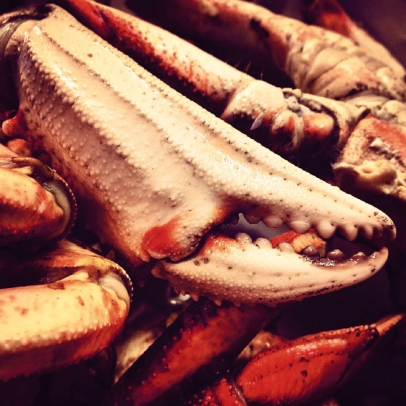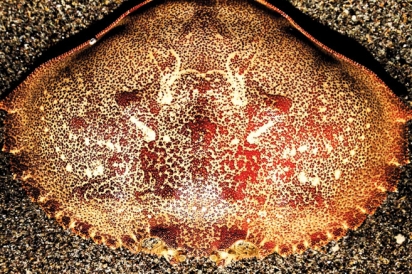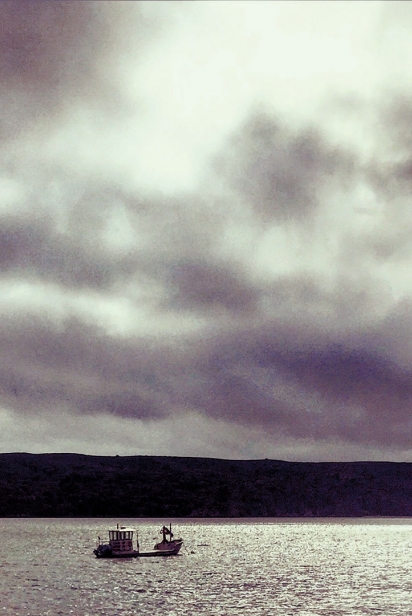The pleasures of crabbing
Northern California’s Highway 1, its crooks and curves hugging tight to the Pacific coastline, was flooded out in the one-horse town of Tomales, preventing my progress farther south towards Point Reyes Station. Desperately needed December rains poured down the now-verdant West Marin hills, washing onto the road boulders, tree limbs and thick piles of red clay soils.
My old wagon doesn’t float, nor would her pristine chassis appreciate the saltwater bath. With a ration of still-warm green tea, wispy crumbs from a wood-fired ham and cheese croissant littering my lap and the horns of Bach’s Brandenburg Concerto Number 1 sounding their opening notes, I doubled back and took the long way.
The rains had called a temporary truce with the saturated earth, now replaced by a limp fog. Herds of cows and tule elk grazed dewy green vistas and enormous turkey vultures, eyes the blood red of their roadkill treasures, perched atop telephone poles, wings open wide to the sky: gargoyles drying themselves of the weather.
All too soon, I arrived to the Tomales Bay public boat launch in the blink-of-an-eye town of Marshall. Fifteen miles in length and one mile at its widest point, Tomales Bay is a long, narrow inlet fed from the ocean and filled with oyster beds, seals and seabirds, all under the safeguard of California’s Bays and Estuaries Policy.
Retrieving worn binoculars from the glove box, I scanned the waters for my ride; a 12-foot motorized skiff captained by a tall, soft-spoken gentleman several years my junior. While I was being re-routed onto drier back roads, he was laying crab traps in various parts of the bay. Gearing up into boots, an old hunting jacket and a scratchy wool cap pulled low over my ears, I took stock of the ever-changing weather.
The skies were a patchwork of gray steel riveted by whitish clouds, hanging low and clinging to the evergreens edging Tomales Bay, a moody plein air painting stretched on Earth’s canvas.
Full throttle propelled us across exceptionally still waters, sending gaggles of geese into noisy flight. Near the mouth of the bay, we cut the engine and floated to the trap planted farthest from the dock, marked by a buoy painted a New England red and white; the wind and waves of the open ocean roiling against Tomales Point in the distance.
The traps were an assortment of metal cages and rings with mesh rope, each weighted with bricks and baited with an aquatic offering of the severed heads of sea bass, their eyes cloudy and stunned at their predicament. With a long gaff, I snagged the buoy and pulled, learning quickly that hauling up the seemingly endless, thick, wet ropes tethered to crab traps heavily laden on the seabed below, while garbed in leather driving gloves, would immediately and forever relinquish the finely tailored pieces to the pockets of my fishing waders. It felt to my aching arms that the crab pot resided miles below us, and knowing that Dungeness can live at depths of 2,000 feet, I asked my companion to take a turn hauling up the trap. He chuckled softly, informing me that Tomales Bay has only a depth of three feet to not much more than 12 or 15 feet, depending on the tide in the shoals and channels. Red-faced and grunting, I kept pulling.
Barring the heartbreaking algae blooms that can produce levels of domoic acid toxins unhealthy to those consuming the crustacean (but not to the crab itself ), the Dungeness season opens at the beginning of November and, every year, without fail, it’s an anticipated meal.
One of the more abundant crabs in the waters north of Monterey Bay, Dungeness (Metacarcinus magister) are sweet and succulent, their gastronomic noteworthiness owed to a diet of clams, crustaceans and smaller fish. They’re easily identified by the white tipped, saw-toothed pincers on the ends of their claws, or chelipeds. Their last three walking legs have a hairy fringe, and the tip on the last segment of the body is rounded, unlike the pointed flap on all other crabs. Dungeness, named for the Port of Dungeness in Washington, are one of the largest edible crabs, growing to a width of nine inches across their reddish-brown backs. While fished in the Pacific from Alaska to Baja, California, Dungeness crabs are not often seen south of Santa Barbara.
Moving to Northern California in winter several lifetimes ago, after all my years spent in the Northeast, I was struck by the profusion of super clean and fancy cars, the seemingly effortless abundance of most everything, Meyer lemons plucked from the tree, January’s light on the Pacific, the splendor of Dungeness crab.
Entirely familiar was I with the brininess of the East Coast’s blue crab, cooked in beer and generously dusted with Old Bay seasoning, and their soft-shelled precursor: that beguiling, disconcerting first bite into their soft, squishy molting bodies in early summer, lightly battered, fried and served on a roll slathered with spicy remoulade. The bile-yellow muckiness of England’s Dorset crab boasts a legion of fans (no doubt the same palates that prefer their wild fowl foul). The rock-hard claws of Florida’s stone crab require a strong arm, a smaller appetite and a desire to see Miami. And while Alaska’s king crabs are massive, their spongy and ubiquitous presence at wedding banquets and mid-tier sushi houses strip their buzz.
In Maine, the Jonah and Peekytoe crabs are prized for their delicacy, but their appearance is infrequent, almost precious, and given my continuing consternation with only possessing a single stomach, when in Bath or Bar Harbor or any dock in between, it’s difficult to choose a crustacean other than a just-caught, two-pound, Vermont-butter-soaked lobster.
The Dungeness crab, however, is Neptune’s gift to the North American West Coast: a harmony of sweet and savory with firm, snowy flesh encased in a shell that barely hints at being difficult to pry open. Indeed, wielding a mallet at the dinner table is imprudent, most assuredly leaving shell shards in the precious meat. While their life expectancy is only 10 years, most Dungeness are commercially harvested at 4. Classified as juveniles for their first two years, they assiduously avoid contact with adult crabs, which have no qualms feasting on the young.
Studies from Oregon’s Department of Fish and Wildlife (ODFW) outlining the crab’s development note juvenile Dungeness’ can molt six times a year, eventually slowing to once a year by age 3. When Dungeness prepare to molt, the crab’s old exoskeleton separates from the new one beneath. The new exoskeleton absorbs water and becomes larger, causing a split at their molt line. This soft-shelled crab, dressed in only the flimsiest of undergarments, now has the flexibility to back out of its old shell. Vulnerable to predators at this stage, it’s a rather quick costume change. Once the crab has exited its former housing, it buries itself in sand, allowing the new shell time to harden. Adult crabs often molt simultaneously, the females shedding in the spring and the males molting later in summer, their shells littering the beach.
Dungeness mate when the adult female is newly molted. In early spring, males seek females likely to soon molt; a striptease with full benefits. Crabs will remain in a pre-mating embrace until the female molts, sometimes as long as two weeks before the spermatophores are deposited. This embrace often continues long afterward to protect the newly molted female, while simultaneously answering the age-old question of how long the male needs to just lie there, holding her after lovemaking has concluded.
In autumn, as further explained by ODFW, the females extrude eggs, fertilizing them with spermatophores stored from spring mating. Initially, these eggs are bright orange and layered on the crab’s underside, a condition often referred to as “berried up.”
As the eggs ready to hatch, they turn black and are released into the water before being carried out to sea.
Like all fisherman, my crabbing buddy had his theories about which area was most conducive to filling our traps. Eel grass beds, shallows, and currents found their way into our conversation. Finally, with dramatic fanfare, the trap was heaved into the boat bearing several angry crabs. Knowing we had a daily bag limit of 10 crabs per person (an obscene amount), and a minimum size limit of 5.75 inches, we measured each crustacean with a crab gauge, trying to avoid the flailing claws on each pissed-off crab. Several too-small Dungeness were tossed back into the chilly bay, but we kept a couple of red crabs. Often overlooked by fisherman in favor of the larger, meatier Dungeness, the red crab (Cancer productus) is colored as billed, with black-tipped pinchers on the ends of their sharp, rough-edged claws. Growing to eight inches in length, red crabs are harvested from Baja to Alaska. Their claw meat is crustacean gold: luscious and firm, with a distinctly briny note.
Both Dungeness and red crabs are members of the Cancridae family and the genus Cancer, meaning hard shell. Their wide, oval carapace bears a saw-toothed grin, and both crabs are among nine species of this family and genus found in the waters off California.
By late afternoon, we’d hauled aboard enough Dungeness and red crab for a decent supper. As the winter sky began to contemplate the evening, we decided to return to the dock, leaving one trap in the waters behind Hog Island, to be hauled up on the next venture out. As I zipped my jacket tightly and reclined in the bow of the boat, trying to light a damp, hastily rolled joint of Mendocino green bud, my normally taciturn fishing mate began to quietly curse. I laughed mercilessly when told the boat was out of gas. As he hitched the oarlocks and oars into place, their metal click announcing his imprisonment for the next while, a dozen seals surrounded the floating skiff, their heads bobbing just above the surface. Many of them followed us to the dock, a good long mile and a sweaty row away.
A well-used stockpot is filled with water and a fistful of salt, and with a nod of gratitude, the crabs are quickly submerged into the raging boil. When their shells achieve the bright red of a Yves Saint Laurent lipstick, they’re fished out and laid to rest on a bed of ice.
The table is laid with layers of newsprint, pinched from a four-finger pile of yellowing Sunday papers kept tucked away in a kitchen corner for just such an occasion. Their sad headlines and beseeching advertisements are covered with white linen napkins, crab crackers and picks, dozens of halved Meyer lemons, bowls of sea salt, warm crusty ciabatta, and a bottle of just-pressed Tuscan oil, its vivid green bite to lace every morsel. A slightly misshapen wooden bowl the size of a baby’s bathtub is filled with chopped chicories, thin slices of persimmon, and tiny lettuces dressed in balsamic, their reds and greens heralding the holiday season. The salad, along with a plate of Medjool dates and a hunk of aged Sonoma goat cheese, its edges now beginning to ooze, would qualify as dessert.
The candles are lit, a 20-year-old Napa Valley Chardonnay is uncorked, and the crabs are placed in the middle of the table, every man for himself style.
“Men go fishing all of their lives without knowing that it is not fish they are after.”
—Henry David Thoreau (1817–62) American author, activist and naturalist
“You cannot teach a crab to walk straight.”
—Aristophanes (446–386 BC), Greek comic playwright
“Have you ever watched a crab on the shore crawling backward in search of the Atlantic Ocean and missing? That’s the way the mind of man operates.”
—H.L. Mencken (1880–1956),
American journalist, satirist, cultural critic and scholar







